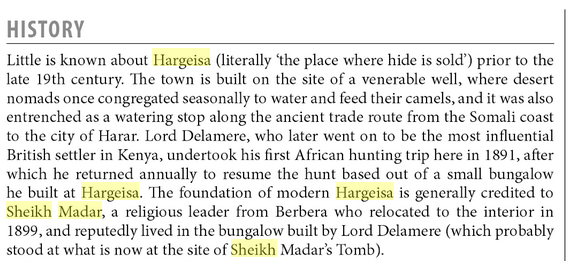Mashaallah Hargeysa was so beautiful back then
Baxsaneey Hargeysaa
Hargeisa was so beautiful in the past.

Mashaallah Hargeysa was so beautiful back then
Baxsaneey Hargeysaa

@macaan can you show us where you got it from, wanna check if there are more somali history there
Yup, I also heard that one before, but loool it's not in old af Somali....it's in af Harari, I believe.
Apparently, Harar's old name used to be Gey(the City) and its inhabitants used to be called Geyusu("the People of the City")





Actually Hargeisa's earliest settlers were Cidagale and Arab. The Togaherer (little Herer) existed even before Sheikh Madar arrived.
That is why the Mad Mullah said in his poem.
"Gadh hunguri galay Habar Yoonis iyo Harar nin joogaa leh (Cidagale)". Hargeisa was called little Herer when it was just a Cidagale/Arab village.

What about the Gabooye living there and being expelled by a sheekh.
Everything has a story that predates the pen. I know of a city in bari that had a Christian ethiopian king controlling it. The name stuck. The story happened and is acknowledged. Do you think hargeysa was settled in the 1800s. I think it was settled since founding of our fathers 1200 to 900 yrs ago.Odey @Grant, this thread is about the established origins of Hargeisa, which is based on first-hand contemporary accounts and supplemented with reliable secondary sources. I am not sure what a medieval myth has to do with Hargeisa, a settlement founded in the 1800s.
Everything has a story that predates the pen. I know of a city in bari that had a Christian ethiopian king controlling it. The name stuck. The story happened and is acknowledged. Do you think hargeysa was settled in the 1800s. I think it was settled since founding of our fathers 1200 to 900 yrs ago.
I highly doubt Hargeisa was settled in the 1200s. However, there were medieval settlements in historic towns like Amud and Aw Barkhadle.
Christian burials?!Later history does not change the archaeology.
"Aw-Barkhadle is located on the eastern side of the Berbera Road that goes through current-day Aw-Barkhadle town. The site of Aw-Barkhadle includes archaeological remains, a ruined town within which the current mausoleum of Saint Aw-Barkhadle is located, as well as different types of burial traditions, including Christian, Muslim, and others of non-Islamic character such as cairns, dolmens and stelae including phallic gravestones. The leaders let themselves be buried at the Aw-Barkhadle site (Mire forthcoming). However, the site was a pre-Islamic centre, and the sacred landscape includes a mountain, trees, stones and well associated with deities, most prominently the sky God. Here, everything has been given a meaning and placed in a divine order. It connects the pre-Islamic/pre-Christian with the Islamic through myths, legends and ancestor worship."
Strongly suggest you read Sada Mire:
https://link.springer.com/article/10.1007/s10437-015-9184-9


Sxb they were living way east of waqooyi galbeed. As far as Bari. Ceel Doo far regionChristian burials?!
What Christians where living in the middle of Somaliland?!
What ethnicity where they?Sxb they were living way east of waqooyi galbeed. As far as Bari. Ceel ****** region
EthiopiansWhat ethnicity where they?
Later history does not change the archaeology.
"Aw-Barkhadle is located on the eastern side of the Berbera Road that goes through current-day Aw-Barkhadle town. The site of Aw-Barkhadle includes archaeological remains, a ruined town within which the current mausoleum of Saint Aw-Barkhadle is located, as well as different types of burial traditions, including Christian, Muslim, and others of non-Islamic character such as cairns, dolmens and stelae including phallic gravestones. The leaders let themselves be buried at the Aw-Barkhadle site (Mire forthcoming). However, the site was a pre-Islamic centre, and the sacred landscape includes a mountain, trees, stones and well associated with deities, most prominently the sky God. Here, everything has been given a meaning and placed in a divine order. It connects the pre-Islamic/pre-Christian with the Islamic through myths, legends and ancestor worship."
Strongly suggest you read Sada Mire:
https://link.springer.com/article/10.1007/s10437-015-9184-9
Wow they lived in Somaliland before. Wait, dose that mean I have Hebesha ancestors?Ethiopians

This is before issaq existed.Wow they lived in Somaliland before. Wait, dose that mean I have Hebesha ancestors?
Then our Dir ancestors must have had fun time with Hebeshi befire Shirk Isaaq came.This is before issaq existed.

Dir were probably og ethiopians and probably rebelled agaisnt themThen our Dir ancestors must have had fun time with Hebeshi befire Shirk Isaaq came.